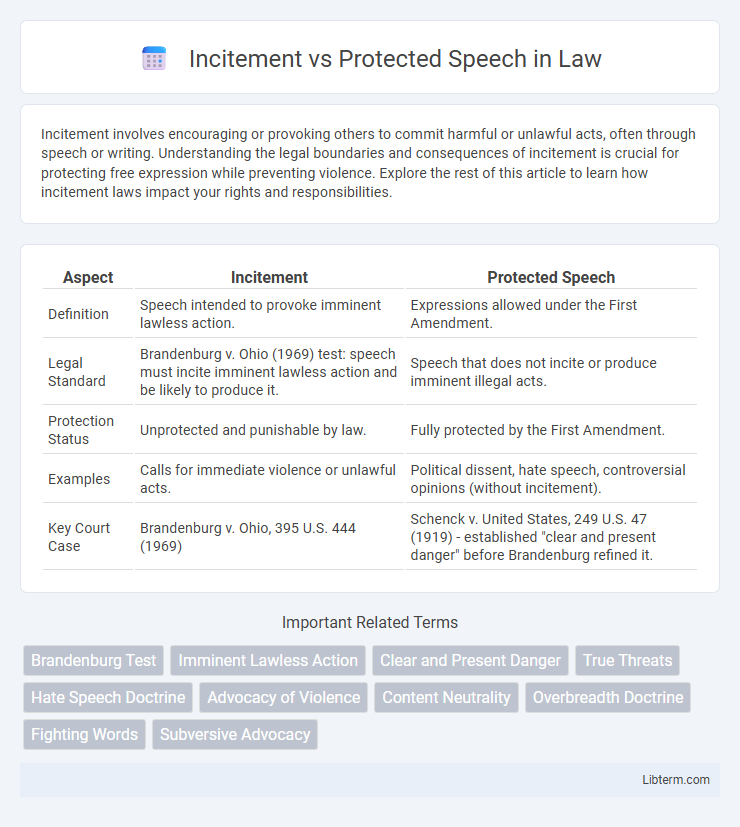Incitement involves encouraging or provoking others to commit harmful or unlawful acts, often through speech or writing. Understanding the legal boundaries and consequences of incitement is crucial for protecting free expression while preventing violence. Explore the rest of this article to learn how incitement laws impact your rights and responsibilities.
Table of Comparison
| Aspect | Incitement | Protected Speech |
|---|---|---|
| Definition | Speech intended to provoke imminent lawless action. | Expressions allowed under the First Amendment. |
| Legal Standard | Brandenburg v. Ohio (1969) test: speech must incite imminent lawless action and be likely to produce it. | Speech that does not incite or produce imminent illegal acts. |
| Protection Status | Unprotected and punishable by law. | Fully protected by the First Amendment. |
| Examples | Calls for immediate violence or unlawful acts. | Political dissent, hate speech, controversial opinions (without incitement). |
| Key Court Case | Brandenburg v. Ohio, 395 U.S. 444 (1969) | Schenck v. United States, 249 U.S. 47 (1919) - established "clear and present danger" before Brandenburg refined it. |
Understanding Incitement and Protected Speech
Incitement refers to speech that is intended and likely to provoke imminent lawless action, thus losing First Amendment protection, as established in the landmark Supreme Court case Brandenburg v. Ohio (1969). Protected speech encompasses expressions that do not incite immediate violence or unlawful activities, safeguarding freedom of expression under the First Amendment. Distinguishing between incitement and protected speech requires analyzing the intent, likelihood, and imminence of unlawful conduct resulting from the speech.
Legal Definitions: Incitement vs Protected Speech
Incitement refers to speech that is intended and likely to provoke imminent lawless action, as defined by the Supreme Court in Brandenburg v. Ohio (1969), and thus falls outside First Amendment protection. Protected speech encompasses expressions, including political dissent and controversial opinions, that do not meet the threshold of inciting immediate violence or illegal acts. The legal distinction hinges on the intent and likelihood of causing imminent harm, safeguarding free speech while preventing dangerous conduct.
Historical Context of Free Speech Laws
The historical context of free speech laws reveals a complex balance between protecting individual expression and preventing incitement to violence. Landmark cases such as Brandenburg v. Ohio (1969) established the "imminent lawless action" test, distinguishing protected speech from speech that incites illegal acts. This legal framework reflects centuries of evolving doctrines shaped by political, social, and legal challenges to free expression in the United States.
Key Supreme Court Cases Shaping Speech Boundaries
The Supreme Court's ruling in Brandenburg v. Ohio (1969) established the "imminent lawless action" standard, limiting incitement prosecution to speech directed to incite or produce immediate illegal activity. In Chaplinsky v. New Hampshire (1942), the Court differentiated between protected speech and "fighting words" that inflict injury or incite breach of peace. These landmark cases have shaped the boundaries of free speech by defining when expression crosses into unprotected incitement under the First Amendment.
The “Clear and Present Danger” Test
The "Clear and Present Danger" test evaluates whether speech poses an immediate threat significant enough to justify restriction, balancing First Amendment protections with public safety. Originating from Schenck v. United States (1919), this standard requires the government to prove that the incitement to unlawful action is both imminent and likely. Courts apply this test to distinguish protected speech from incitement, ensuring that only speech directly linked to imminent illegal conduct is subject to limitation.
Brandenburg v. Ohio and Modern Incitement Standards
The landmark case Brandenburg v. Ohio (1969) established the modern standard for incitement, ruling that speech is unprotected only if it is directed to inciting imminent lawless action and is likely to produce such action. This decision refined previous tests by emphasizing both the intent and immediacy of the unlawful conduct the speech seeks to provoke. Current legal interpretations require a clear and present danger of imminent harm, distinguishing protected political expression from punishable incitement.
Social Media’s Role in Amplifying Incitement
Social media platforms facilitate rapid dissemination of incitement by enabling users to share provocative content with vast audiences, often blurring the line between protected speech and unlawful incitement. Algorithms prioritize engagement, which can amplify incendiary messages, increasing risks of real-world violence and hate crimes. Legal frameworks struggle to balance First Amendment protections with the necessity to curb harmful speech amplified by platforms like Facebook, Twitter, and TikTok.
Distinguishing Hate Speech from Protected Expression
Incitement involves speech intended to provoke imminent lawless action, which is not protected under the First Amendment, whereas protected expression includes speech that, while offensive or hateful, does not directly lead to immediate violence. Legal criteria from landmark cases like Brandenburg v. Ohio establish that hate speech is only punishable when it meets the strict threshold of inciting imminent illegal acts. Distinguishing between unlawful incitement and protected hate speech requires analyzing the intent, imminence, and likelihood of the speech provoking harmful behavior.
Impacts of Incitement Laws on Public Discourse
Incitement laws, designed to prevent speech that provokes imminent lawless action, significantly influence public discourse by imposing limits on expression to safeguard societal order. These laws often create a balance between protecting freedom of speech under the First Amendment and mitigating the risks of violence or unrest triggered by incendiary rhetoric. The enforcement of incitement statutes can curb extremist speech but may also raise concerns about overreach and chilling effects on legitimate political debate and activism.
Balancing Free Speech Rights and Public Safety
Incitement involves speech that directly provokes imminent lawless action, which is not protected under the First Amendment, whereas protected speech encompasses expressions that do not pose an immediate threat to public safety. Courts employ the "Brandenburg test" to distinguish incitement from lawful expression, requiring intent, imminence, and likelihood of illegal conduct. Balancing free speech rights with public safety demands careful judicial scrutiny to prevent censorship without enabling harm or violence.
Incitement Infographic

 libterm.com
libterm.com